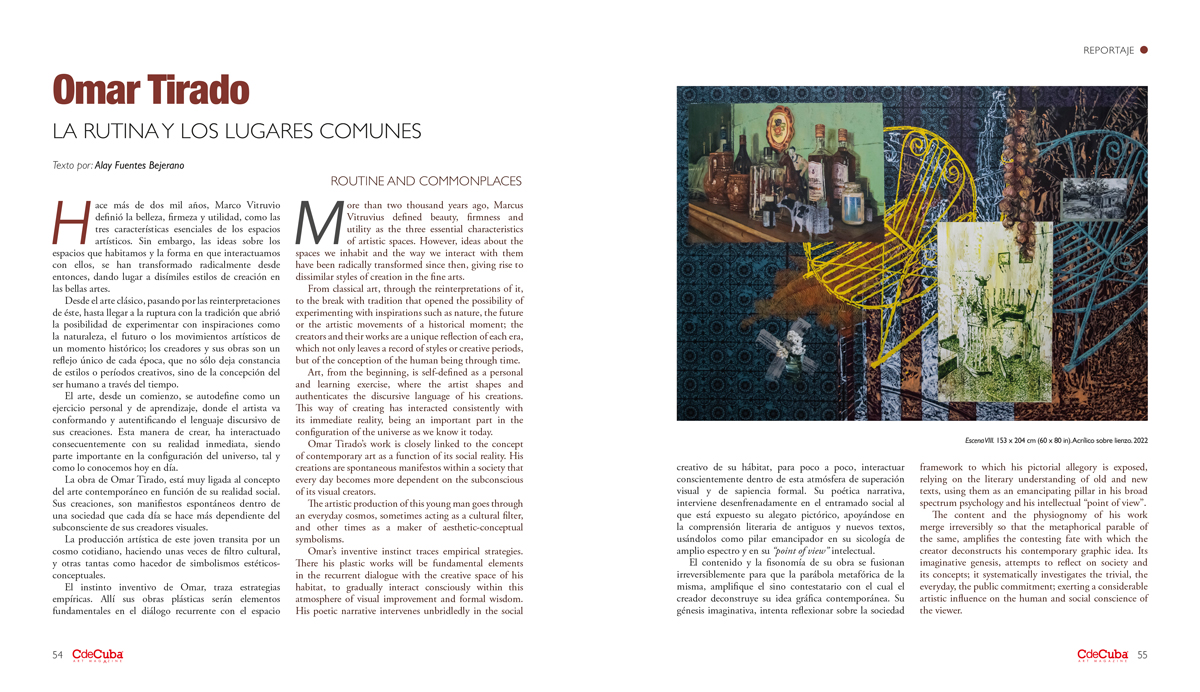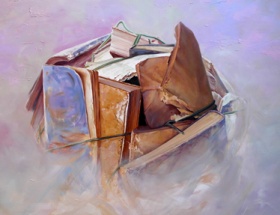Routine and Commonplaces
By Alay Fuentes Bejerano
More than two thousand years ago, Marcus Vitruvius defined beauty, firmness and utility as the three essential characteristics of artistic spaces. However, ideas about the spaces we inhabit and the way we interact with them have been radically transformed since then, giving rise to dissimilar styles of creation in the fine arts.
From classical art, through the reinterpretations of it, to the break with tradition that opened the possibility of experimenting with inspirations such as nature, the future or the artistic movements of a historical moment; the creators and their works are a unique reflection of each era, which not only leaves a record of styles or creative periods, but of the conception of the human being through time.
Art, from the beginning, is self-defined as a personal and learning exercise, where the artist shapes and authenticates the discursive language of his creations. This way of creating has interacted consistently with its immediate reality, being an important part in the configuration of the universe as we know it today.
Omar Tirado’s work is closely linked to the concept of contemporary art as a function of its social reality. His creations are spontaneous manifestos within a society that every day becomes more dependent on the subconscious of its visual creators.
The artistic production of this young man goes through an everyday cosmos, sometimes acting as a cultural filter, and other times as a maker of aesthetic-conceptual symbolisms.
Omar’s inventive instinct traces empirical strategies. There his plastic works will be fundamental elements in the recurrent dialogue with the creative space of his habitat, to gradually interact consciously within this atmosphere of visual improvement and formal wisdom. His poetic narrative intervenes unbridledly in the social framework to which his pictorial allegory is exposed, relying on the literary understanding of old and new texts, using them as an emancipating pillar in his broad spectrum psychology and his intellectual “point of view”.
The content and the physiognomy of his work merge irreversibly so that the metaphorical parable of the same, amplifies the contesting fate with which the creator deconstructs his contemporary graphic idea. Its imaginative genesis, attempts to reflect on society and its concepts; it systematically investigates the trivial, the everyday, the public commitment; exerting a considerable artistic influence on the human and social conscience of the viewer.
Space, symbology, house interiors, landscape, drawing and painting are an inseparable part of the works in question. They are conceptually influenced by pictorial antecedents such as Pablo Picasso and Wilfredo Lam, without forgetting his irrefutable attachment to the Russian constructivist current.
A deceptive chaos appropriates the visuality of the proposal. The viewer is confronted with an aesthetic discourse well grounded in the paradigms of 20th century French sociology, in the Freudian patterns of modern psychology. The thematic character of these creations transgresses their support, to be reborn as “influencer” of a generation of three-dimensional inhabitants.
The works not only describe the intimate relationship between social fables, but also provide a space for sensitive and reflective dialogue, in view of the imminent need for an ideo-aesthetic understanding of contemporary Cuban art. This analysis introduces us to the compositional core of the work itself, relates us to enigmas and events that surround it, which are the essential elements for its subsequent comprehension.
With the prophylactic use of the plastic nature of the materials, he processes this crusade in pursuit of new scenarios, in search of dreamlike galaxies. He uses collage images, highly superimposed and deconstructed, in order to strip his social-artistic discourse of any kind of cultural script, turning his works into a flow of analogous, complementary ideas, saturated with sensorial harmony.
His artistic presupposition is completely interested in the production involved with its social context, but not from a generous commitment that assumes as its own the responsibility of change. For him it is about the value of the reflection that arises from the dialogue with a political-social otherness, with which he maintains a certain core affinity, and at the same time a contesting contradiction, in search of the necessary friction essential for the production of knowledge, symbolism and meaning.
Its characters converge in a unique and unrepeatable fable that subtly reaffirms the way of seeing the world, its exquisite, moving and even real dialogues intuitively contemplate a spectator tired of banalities and avid for another austere and intelligent discourse.
Omar Tirado’s irreverent cosmogony allows us to become aware of our own life experience, to take it as a challenge to face the questions of this contemporary cosmovision of art, in the society we shape and inhabit, turning it into our world.






